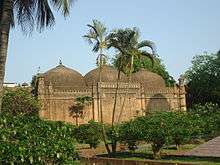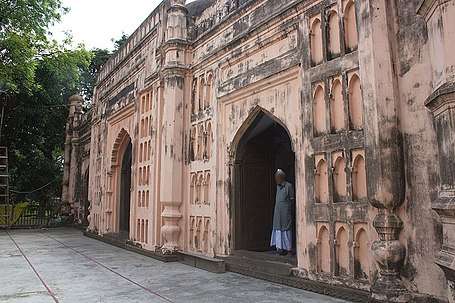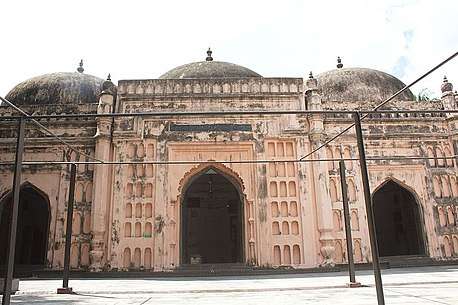Shahbaz Khan Mosque
Shahbaz Khan Mosque is a historic mosque located in Dhaka, Bangladesh.
| Shahbaz Khan Mosque | |
|---|---|
 | |
| Religion | |
| Affiliation | Hanafi/Sunni |
| Status | active |
| Location | |
| Location | Teen Netar Mazar in Shahabag, Dhaka, Bangladesh |
| Geographic coordinates | 23.7294°N 90.4003°E |
History
A merchant of prince of Dhaka who built the mosque as well as his own Dargah Sharif during his lifetime in - 1086 (h).It is an Islamic architecture. Now its present condition is good. Shahbaz Khan Mosque situated in the old high court area. In 1950 the Eastern circle of the Pakistan Directorate of Archaeology (DOA) took over both the Haji khwaja Shahbaj Masjid, and the adjacent square mazar. Shah baz khan built the mazar and post. This mosque and tomb, constructed in 1679 by Haji khwaja Shahbaz, a rich merchant of Dhaka, remains the city's most refined mosque.
Architecture

Its high fortified walls and occasional bastions were encroached upon, destruction, defacement of different structures and changes in internal spaces, had put the fort in a sorry state. The two-storied diwan block was partly damaged; bathhouse, niches were filled in, and decorative panels were mostly plastered over. The DOA accomplished a good job in restoring the structure and converting it into a museum in the first place, but the pinkish finish on the exterior, rather than the original lustrous white, fueled debates and controversies. The elegance of its interior bespeaks the patron's wealth. The mosque's interior is divided into three bays by two lateral cusped arches supported by stone piers embedded in the east and west walls. Yet the Directorate restored the do-chala roof on the veranda at the south of the tomb and the decorative features like engaged corner turrets. This appears to be the first use of lateral cusped arches in a Bengali mosque's interior, and was doubtless inspired by imperial mughal architecture. The central Mihrab, particularly noteworthy, is highly ornamented with Cyprus-filled kanjuras, ornate arabesque plastic relief in the spandrels, a cusped arch, and engaged colonettes standing on bulbous floral bases. Due east of the mosque is the small, square, single-domed tomb with engaged turrets at each corner. Attached to the Southside was a low rectangular chamber with a do-chala roof, now collapsed. While the purpose of this room is not clear, it perhaps served as a prototype for the more symmetrical tomb of Khwaja Anwar-i Shahid in Burdwan. It reconstructed the brick podium and provided adequate provision for ablution, plumbing, and sanitation services. The front façade of the mosque has three arched openings within four slender columns. Historically in Mughal architecture the standard architectural design was having two columns on the east façade of the mosque, but this mosque has four.[1] It also has four corner turrets, ribbed and engaged. Earlier in it also has four corner turrets, ribbed and engaged. In a way the other two mosques built slightly later than this one bear similar features, but in an improved form. It is something that we now identify as a distinct Mughal style in Bengal.
It also worked on other structures, too. It shied away from proper excavation and documentation of the intricate water supply system a network of terracotta pipes, an aqueduct, a water reservoir and several fountains, until recently.
Present condition
Due to its uninterrupted use and some care and maintenance since then the mosque did not require any renovation. However, in the past, the Department of Archaeology (DOA) have made several unacceptable modifications while carrying out periodic repairs. Like in and around many other heritage structures all over the country, the premises of Shahbaz Khan mosque is occupied by religious groups building illegal structures and extensions to the listed building, ignoring its heritage value that they abuse, building codes and rules, fiercely protecting their possessions.


References
- Michell, George, ed. (1984). The Islamic Heritage of Bengal. UNESCO. ISBN 92-3-102174-5. Retrieved 2019-12-09.
| Wikimedia Commons has media related to Shahbaz Khan Mosque. |
- The Islamic Heritage of Bengal, UNESCO,ISBN 92-3-102174-5
- Mahbubur Rahman "City of an architect ’, Delivistaa Foundation, ISBN 978 984 33 24511, 2011
- Mahfuzal Haque and Zahirul Haque 2006. "Tourist Attractions of Bangladesh", External Publicity Wing, Ministry of Foreign Affairs, Government of Bangladesh
- “Khwaja Shahbaz Tomb.” Archnet, archnet.org/sites/15897.

_002.jpg)